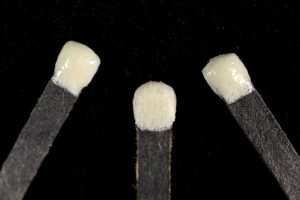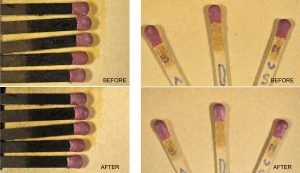By Roger Williams, Conservation Fellow
We recently treated a scrapbook once belonging to Ardis Nadine Kuhnen, an Evanston resident and Northwestern alumna (B.S. ’51). The book, which came to us from University Archives, details Ardis’ trips to some local restaurants and bars in 1947.
Though the book suffers from other typical ailments, it came down to the lab for a particularly striking concern: matches. Ardis collected restaurant matchbooks (and other ephemera) and glued them to the scrapbook pages next to her handwritten entries. Most of the matches were removed before the cardboard books were adhered, but four still have the matches themselves remaining:

- 2 books from Bar o’ Music (64 E Lake Street, Chicago)
- 1 book from LoMar’s Pharmacy (Evanston)
- 1 book from The Plantation (Woodruff, WI)
Though perfectly charming, the idea of exposed match heads sitting among piles of paper is enough to make any curator nervous.
Matches have a medley of ingredients that perform roles vital to the ignition process. There are two main categories: “safety” matches and “strike-anywhere” matches. The primary difference between the two is the location of the phosphorus, which is contained in the head on a strike-anywhere match (as phosphorus sesquisulfide) and in the striking strip of a book of safety matches (as red phosphorus). No combustion can occur in a safety match without the red phosphorus; they require contact with the strip to function.
Safety matches were invented in the mid-19th century and quickly became the norm. It is highly likely that the matches in our scrapbook are safety matches, and therefore cannot spontaneously combust without access to their striking strips. And, after seventy years of aging, it is likely that the ingredients in the match heads have degraded enough that they pose no risk. If you’ve ever tried lighting an old box of matches, you may have experienced (with some frustration) that they don’t last forever.
Despite all of this, we decided that the match heads in this scrapbook still posed a level of risk that we weren’t comfortable with. The curator didn’t want us to remove the heads, as is common practice, to avoid disrupting their aesthetic value. We considered quarantining the match heads in polyester film sleeves, but in the end, we wanted something a little less clunky.
We decided to test out some coatings on modern match heads to see if we could prevent ignition. Three acrylic dispersions were selected: Lascaux 498-HV, Golden Matte Medium, and Golden Fluid Matte Medium. All of these have relatively high glass transition temperatures, meaning they aren’t tacky at room temperature and can make for appropriate exposed coatings.

Two layers of the acrylics were applied to the heads of modern matches and allowed to dry. Following three days of curing, it was time for the fun part: trying to ignite the coated matches.
But, of course, safety concerns had to be taken into account. We spoke with our facilities operations team: where would be a good place to perform the test? (This required some explanation. But, luckily, our experiment was taken very seriously.) The answer was clear and forthright: just, y’know, go outside.
We didn’t want the strong winds coming from Lake Michigan to contaminate the experiment with false positives (i.e., blowing out the matches before they even lit), so we got permission to perform the test on the library’s loading dock, which is protected by two walls.

And: success! Despite multiple attempts to strike each match, none of them ignited. After repeated attempts, the match heads broke, but not a single spark was seen.

Though all three acrylic coatings passed the test, we settled on Golden Matte Medium as the winner, since it caused the least amount of gloss while remaining mostly transparent. All match heads in the scrapbook received three coatings: first, a dilute layer to encourage more penetration; then two coatings of undiluted acrylic. Because the match heads were actually glued down to the scrapbook pages, great care had to be taken to apply the acrylic without spillover. And, after two days of curing, the scrapbook was returned to University Archives, where it will ignite nothing but curiosity.
